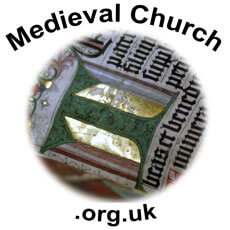Synopsis
BENEDICT OF NURSIA, b. in 480, at
Nursia, in the province of Valeria; d. March 21, 543, at Monte Casino; was
educated in Rome, but fled from the city in 494, only fourteen years old,
disgusted at the worldliness and confusion, both of the students and the
studies, and retired first to Enfide (the old Anfidena, the present Alfidena),
and then farther east, among the mountains, to Subiago, in order to perfect
himself in holiness by a life of seclusion and devotion. At Subiago he met with
a monk, Romanus, who encouraged him in his purpose, and aided him in carrying
it out. lie took up his abode at the bottom of a dismal cavern; and here he
spent the time in holy contemplations, and fighting the temptations of the
flesh, provided with food by Romanus, who, by means of a rope, lowered down to
hini daily a part of his own scanty ration. After the lapse of three years (in
497) he was discovered by some shepherds, who first shrank back from him as
from a wild animal, but soon recognized the signs of a holy life in the
apparition, and prostrated themselves before him. Others were attracted.
Gradually lie was drawn out of this utter seclusion; and in 510 the monks of
the Monastery of Vicovaro chose him their abbot. At this time he seems to have
abandoned the austere asceticism which he originally professed; for he allowed
his monks to drink wine. But the unconditional obedience he demanded, and the
strict regularity which he enforced in the hourly alternation of devotional
practices and manual labor, exasperated them; and they tried to poison him. He
left the monastery, and returned to the cavern; but the world's eye was once
set upon him, as upon a light lit in the darkness. Much people gathered around
him, - delicate youths of rich families, old roughs from the Gothic hordes, -
to obtain his guidance to a holy life. He organized minor communities of twelve
monks under an abbot, and established twelve such ceniobies in the neighborhood
of Subiago, constituting himself supreme abbot. But new troubles arose. Though
monastic life was still a wild-growing plant, without any clearly defined
mission, without any thoroughly developed organization, and consequently liable
to fall into the most singular aberrations, it was, nevertheless, to all men's
eyes, the highest expression of the religious cravings of the age. To enter a
monastery was considered the only true conversio, to live in a
monastery, the only true religio. Hence arose a bitter jealousy from the
side of the secular clergy towards the monks. A priest from the neighborhood of
Subiago, Florentius, actually tried to poison Benedict; and, when this failed,
he attempted to seduce the monks by sensual temptations. Benediet then
determined to leave the place; and in 528 he led his little army into Campania,
to Monte Casino, where he transformed an old Apollo temple, with its adjacent
grove, into a Christian oratory iii the centre of a circle of cenobies. In 529
he promulgated his famous rules, which were destined to be, through many
centuries, the rules of all the monasteries of the Western Church., The
monastery of Monte Casino grew rapidly, and was soon able to send out colonies.
In 550 it was destroyed by the Lombards, the monks fleeing to Rome, and it was
not rebuilt until 720; but in the mean time (in 633) a French monk, Aiguif, dug
up the bones of Benedict, and carried them to France, where they were deposited
in a monastery near Fleury, - a circumstance, which, however, does not prevent
the present monks of Monte Casino to exhibit the bones of the founder of their
order, together with a bull of Urban II., condemning all who doubt the
genuineness of the exhibit.
Philip Schaff, ed., A Religious
Encyclopaedia or Dictionary of Biblical, Historical, Doctrinal, and Practical
Theology, 3rd edn, Vol. 1. Toronto, New York & London: Funk &
Wagnalls Company, 1894. pp.240-241.
 |
 D.V. Adalbert, The Life of
St Benedict. St Bede's Publications, 1993. Pbk. ISBN: 0932506771.
pp.186. D.V. Adalbert, The Life of
St Benedict. St Bede's Publications, 1993. Pbk. ISBN: 0932506771.
pp.186. |
 |
Andre Borias,
"The Spiritual Dynamism of St. Benedict," American Benedictine Review 46.3 (1995): 271-282. |
 |
Maria
Boulding, ."Prayer and the Paschal Mystery According to Saint Benedict," Downside Review 94.4 (1976): 276-286. |
 |
John C.
Cavadini, "A Note on Gregory's Use of Miracles in The Life and Miracles of St.
Benedict," American Benedictine Review 49.1 (1998): 104-120. |
 |
Dom John Chapman [1865-1933], Saint Benedict and the Sixth Century. London: Sheed & Ward, 1929. Hbk. pp.239.  pdf [This material is in the Public Domain] pdf [This material is in the Public Domain] |
 |
Pope
Gregory the Great, Life and Miracles of St Benedict. The Liturgical
Press, 1986. Pbk. ISBN: 0814603211. pp.87. |
 |
Jean
Gribomont, "Prayer in Eastern Monasticism and in Saint Benedict," Word and
Spirit 2 (1981): 3-22. |
 |
Adrian
Hastings, "The Contribution of St Benedict to European Civilization," Downside Review 114(394) (1996): 56-69. |
 |
Basil
Hume, In Praise of St Benedict. St Bede's Publications. Pbk. SBN:
0932506933. pp.88. |
 |
J.E. Lawyer,
"Longing that Loss in the Life of St. Benedict According to Gregory the Great," American Benedictine Review 54.1 (2003): 72-95. |
 |
Jean
Lecleroq, ."Violence and the Devotion to St. Benedict in the Middle Ages," Downside Review 88(293) (1970): 344-360. |
 |
Jean
Lecleroq, "The Problem of Social Class and Christology in Saint Benedict," Word and Spirit 2 (1981): 33-51. |
 |
Malachy
Marrion, "St. Benedict: Listening, Conversion and Constant Prayer," Studies
in Formative Spirituality 5.2 (1984): 209-211. |
 |
Andrew
Nugent, "Benedict: A Sense of Prayer," American Benedictine Review 50.2
(1999): 149-160. |
 |
Adalbert de
Vogue, "Benedict, Model of the Spiritual Life (according to the Second Book of
the Dialogues of St. Gregory," Word and Spirit 2 (1981):
59-72. |
Related Subjects
 Timothy Fry, translator, Rule of Saint Benedict in English. Liturgical Press, 1982. Pbk. ISBN:
0814612725. pp.96.
Timothy Fry, translator, Rule of Saint Benedict in English. Liturgical Press, 1982. Pbk. ISBN:
0814612725. pp.96.  D.V. Adalbert, The Life of
St Benedict. St Bede's Publications, 1993. Pbk. ISBN: 0932506771.
pp.186.
D.V. Adalbert, The Life of
St Benedict. St Bede's Publications, 1993. Pbk. ISBN: 0932506771.
pp.186. 










